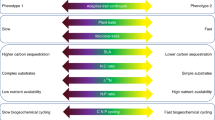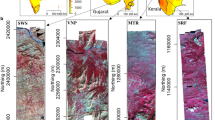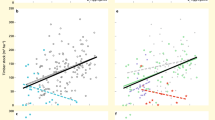Abstract
Tropical forest functional diversity, which is a measure of the diversity of organismal interactions with the environment, is poorly understood despite its importance for linking evolutionary biology to ecosystem biogeochemistry. Functional diversity is reflected in functional traits such as the concentrations of different compounds in leaves or the density of leaf mass, which are related to plant activities such as plant defence, nutrient cycling, or growth. In the Amazonian lowlands, river movement and microtopography control nutrient mobility, which may influence functional trait distributions. Here we use airborne laser-guided imaging spectroscopy to develop maps of 16 forest canopy traits, throughout four large landscapes that harbour three common forest community types on the Madre de Dios and Tambopata rivers in southwestern Amazonia. Our maps, which are based on quantitative chemometric analysis of forest canopies with visible-to-near infrared (400–2,500 nm) spectroscopy, reveal substantial variation in canopy traits and their distributions within and among forested landscapes. Forest canopy trait distributions are arranged in a nested pattern, with location along rivers controlling trait variation between different landscapes, and microtopography controlling trait variation within landscapes. We suggest that processes of nutrient deposition and depletion drive increasing phosphorus limitation, and a corresponding increase in plant defence, in an eastward direction from the base of the Andes into the Amazon Basin.
This is a preview of subscription content, access via your institution
Access options
Subscribe to this journal
Receive 12 print issues and online access
$259.00 per year
only $21.58 per issue
Buy this article
- Purchase on Springer Link
- Instant access to full article PDF
Prices may be subject to local taxes which are calculated during checkout





Similar content being viewed by others
References
von Humboldt, A. Aspects of Nature in Different Lands and Different Climates (Lea and Blanchard, 1850).
Tilman, D. Functional diversity. Encycl. Biodiv. 3, 109–120 (2001).
Ostle, N. J. et al. Integrating plant-soil interactions into global carbon cycle models. J. Ecol. 97, 851–863 (2009).
Fine, P. V. A. et al. The growth-defense trade-off and habitat specialization by plants in Amazonian forests. Ecology 87, S150–S162 (2006).
Asner, G. P. & Martin, R. E. Canopy phylogenetic, chemical and spectral assembly in a lowland Amazonian forest. New Phytol. 189, 999–1012 (2011).
ter Steege, H. et al. Continental-scale patterns of canopy tree composition and function across Amazonia. Nature 443, 444–447 (2006).
Quesada, C. et al. Regional and large-scale patterns in Amazon forest structure and function are mediated by variations in soil physical and chemical properties. Biogeoscience 6, 3993–4057 (2009).
Asner, G. P. et al. Amazonian functional diversity from forest canopy chemical assembly. Proc. Natl Acad. Sci. USA 111, 5604–5609 (2014).
Geological Map of Peru (Instituto Geologico Minero y Metalurgico, 2000)
Hoorn, C. et al. Amazonia through time: Andean uplift, climate change, landscape evolution, and biodiversity. Science 330, 927–931 (2010).
Hamilton, S. K., Kellndorfer, J., Lehner, B. & Tobler, M. Remote sensing of floodplain geomorphology as a surrogate for biodiversity in a tropical river system (Madre de Dios, Peru). Geomorphology 89, 23–38 (2007).
Rosenqvist, A., Forsberg, B. R., Pimentel, T., Rauste, Y. A. & Richey, J. E. The use of spaceborne radar data to model inundation patterns and trace gas emissions in the central Amazon floodplain. Int. J. Remote Sensing 23, 1303–1328 (2002).
Féret, J-B. & Asner, G. P. Microtopographic controls on lowland Amazonian canopy diversity from imaging spectroscopy. Ecol. Appl. 24, 1297–1310 (2014).
Vitousek, P. M. Nutrient cycling and nutrient use efficiency. Am. Nat. 119, 553–572 (1982).
Weng, J-K. & Chapple, C. The origin and evolution of lignin biosynthesis. New Phytol. 187, 273–285 (2010).
Coley, P. D., Kursar, T. A. & Machado, J-L. Colonization of tropical rain forest leaves by epiphylls: Effects of site and host-plant leaf lifetime. Ecology 74, 619–623 (1993).
Niinemets, U. & Kull, O. Stoichiometry of foliar carbon constituents varies along light gradients in temperate woody canopies: Implications for foliage morphological plasticity. Tree Physiol. 18, 467–479 (1998).
Asner, G. P. et al. Carnegie Airborne Observatory-2: Increasing science data dimensionality via high-fidelity multi-sensor fusion. Remote Sensing Environ. 124, 454–465 (2012).
Kalliola, R., Puhakka, M., Salo, J., Linna, A. & RÃsÃnen, M. Mineral nutrients in fluvial sediments from the Peruvian Amazon. Catena 20, 333–349 (1993).
Kvist, L. P. & Nebel, G. A review of Peruvian flood plain forests: Ecosystems, inhabitants and resource use. Forest Ecol. Manage. 150, 3–26 (2001).
Räsänen, M. E., Salo, J. S., Jungnert, H. & Pittman, L. R. Evolution of the Western Amazon Lowland Relief: Impact of Andean foreland dynamics. Terra Nova 2, 320–332 (1990).
Schuur, E. A. G., Chadwick, O. A. & Matson, P. A. Carbon cycling and soil carbon storage in mesic to wet Hawaiian montane forests. Ecology 82, 3182–3196 (2001).
Householder, J. E., Janovec, J. P., Tobler, M. W., Page, S. & Lähteenoja, O. Peatlands of the Madre de Dios River of Peru: Distribution, geomorphology, and habitat diversity. Wetlands 32, 359–368 (2012).
Townsend, A. R., Cleveland, C. C., Asner, G. P. & Bustamante, M. M. C. Controls over foliar N:P ratios in tropical rain forests. Ecology 88, 107–118 (2007).
Richey, J. E. et al. Organic matter and nutrient dynamics in river corridors of the Amazon Basin and their response to anthropogenic change. Geophys. Res. 97, 3787–3804 (1997).
Koerselman, W. & Meuleman, A. F. M. The vegetation N:P ratio: A new tool to detect the nature of nutrient limitation. J. Appl. Ecol. 33, 1441–1451 (1997).
Killingbeck, K. T. Nutrients in senesced leaves: Keys to the search for potential resorption and resorption efficiency. Ecology 77, 1716–1728 (1996).
Melillo, J. M., Aber, J. D. & Muratore, J. F. Nitrogen and lignin control of hardwood leaf litter decomposition dynamics. Ecology 63, 621–626 (1982).
Chapin, F. S. III, Vitousek, P. M. & Van Cleve, K. The nature of nutrient limitation in plant communities. Am. Nat. 127, 48–58 (1986).
Wright, I. J. et al. The worldwide leaf economics spectrum. Nature 428, 821–827 (2004).
Nikitina, D., Remizova, L. & Losco, R. L. A preliminary investigation of the soils and geomorphology of a portion of the Madre de Dios Region, Peru. Soil Surv. 52, 40–47 (2011).
Feilhauer, H., Asner, G. P., Martin, R. E. & Schmidtlein, S. Brigthness-normalized partial least squares regression for hyperspectral data. J. Quant. Spectrosc. Radiat. Transfer 111, 1947–1957 (2010).
Asner, G. P., Martin, R. E., Anderson, C. B. & Knapp, D. E. Quantifying forest canopy traits: Imaging spectroscopy versus field survey. Remote Sensing Environ. 158, 15–27 (2015).
Asner, G. P. et al. Carnegie airborne observatory: In-flight fusion of hyperspectral imaging and waveform light detection and ranging for three-dimensional studies of ecosystems. J. Appl. Remote Sensing 1, 013536 (2007).
Haaland, D. M. & Thomas, E. V. Partial least-squares methods for spectral Analyses. 1. Relation to other quantitative calibration methods and the extraction of qualitative information. Anal. Chem. 60, 1193–1202 (1988).
Asner, G. P. et al. Spectroscopy of canopy chemicals in humid tropical forests. Remote Sensing Environ. 115, 3587–3598 (2011).
Wold, S., Sjostrom, M. & Eriksson, L. PLS-regression: A basic tool of chemometrics. Chemometr. Intell. Lab. Syst. 58, 109–130 (2001).
Chen, S., Hong, X., Harris, C. J. & Sharkey, P. M. Sparse modeling using orthogonal forest regression with PRESS statistic and regularization. IEEE Trans. Syst. Man Cybern. 34, 898–911 (2004).
Goodman, R. C. et al. Amazon palm biomass and allometry. Forest Ecol. Manage. 310, 994–1004 (2013).
Acknowledgements
This study was funded by the John D. and Catherine T. MacArthur Foundation. The Carnegie Airborne Observatory is made possible by the Avatar Alliance Foundation, Margaret A. Cargill Foundation, John D. and Catherine T. MacArthur Foundation, Gordon and Betty Moore Foundation, Grantham Foundation for the Protection of the Environment, W. M. Keck Foundation, M. A. N. Baker and G. L. Baker Jr, and W. R. Hearst III.
Author information
Authors and Affiliations
Contributions
G.P.A. designed and secured funding for the study, and led data collection and analysis steps. G.P.A., C.B.A., R.E.M., D.E.K., R.T. and F.S. carried out data collection and analyses. G.P.A. and R.E.M. wrote the paper.
Corresponding author
Ethics declarations
Competing interests
The authors declare no competing financial interests.
Supplementary information
Supplementary Information
Supplementary Information (PDF 2164 kb)
Rights and permissions
About this article
Cite this article
Asner, G., Anderson, C., Martin, R. et al. Landscape biogeochemistry reflected in shifting distributions of chemical traits in the Amazon forest canopy. Nature Geosci 8, 567–573 (2015). https://doi.org/10.1038/ngeo2443
Received:
Accepted:
Published:
Issue Date:
DOI: https://doi.org/10.1038/ngeo2443
This article is cited by
-
Foliar Stoichiometry is Marginally Sensitive to Soil Phosphorus Across a Lowland Tropical Rainforest
Ecosystems (2022)
-
Spatially explicit correlates of plant functional traits inform landscape patterns of resource quality
Landscape Ecology (2022)
-
Soil Nutrient Depletion and Tree Functional Composition Shift Following Repeated Clearing in Secondary Forests of the Congo Basin
Ecosystems (2021)



